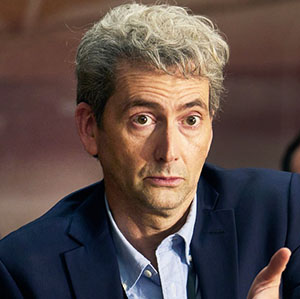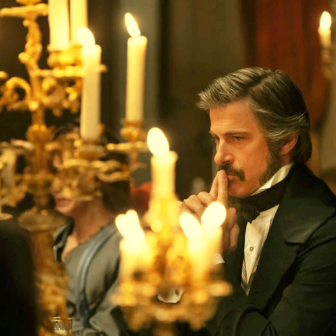Although the doctors say he should have died two years ago, Clive James has been in the news again following a widely reported BBC interview about his latest book of poems, Sentenced to Life. He’s talking about death and jokes.
“The truth is I did die,” he says, “and it’s my ghost that’s talking to you now. But you can’t pull the same stunt twice. You see the problem?”
James has become a presence so fragile you fear he may become transparent under the glare of the cameras, until that smile lights up, and something shines right back – something that does indeed seem almost beyond the constraints of mortality. He is no supernaturalist, but it is as if he has tapped into some arcanum about humour and the vital spark.
A virtuoso of the gag line, he now says he doesn’t like jokes for their own sake. When I had another look at some episodes of his early series Clive James on Television (1982–89), I was struck by how sparing the gags are. The series was based on the principle that there is no better TV comedy than television trying to be serious – advertising paint colour charts on a black-and-white screen, selling decoy duck telephones, or demonstrating Captain Power guns that fire invisible beams at the television set (a ground-breaking early experiment in interactivity). And nothing could be funnier than the Eurovision Song Contest. For Clive James the TV critic, it had pride of place in the calendar.
Someone who takes the Eurovision Song Contest seriously is Stephen Oliver, writer-producer of Stop Laughing… This is Serious, a three-part ABC series that offers a brief history of Australian television comedy. Oliver’s 2011 documentary The Secret History of Eurovision set out to show the real political significance of a kitsch-fest whose evolution is “the story of Europe itself.” It was a well-conceived documentary and you’d certainly learn more about Eurovision from it than from James’s facetious tours de force in the UK Telegraph, but viewing The Secret History again I am struck by its lack of any instinct for the facetious. In Stop Laughing, this comes across as a rather earnest way of looking at the business of comedy.
“Kel! Kel come and watch this show it’s a f-fascinating documentary about Astrayn comedy.” Jane Turner speaks this opening line to camera in the first program, flat-voiced and without any of Kath’s look-at-me hair and make-up enhancement. The upwardly mobile Kath and Kel would of course take their ABC documentaries seriously. The series alternates between clips from defining examples of Australian television comedy, and commentary from some of the best-known personalities involved. It’s deftly edited and moves along briskly, but the voiceover script (delivered by Eric Bana) is curiously pedantic.
“We Aussies are masters of finding humour in diversity,” he solemnly tell us, and “we especially respect fearlessness in the face of authority – however serious the situation may be.” This comment introduces Norman Gunston’s finest moment, as he infiltrates the scene of Gough Whitlam’s dismissal in 1975. Gunston starts by moving in on Bob Hawke, who pushes the microphone away: “No, look, it’s a bit too serious for that.” “It certainly is,” Gunston chimes in, then edges further along, coinciding with Gough Whitlam on the steps of Parliament House. It’s a photo-bomber’s dream, and for a couple of seconds Gunston fronts the cameras, mugging and mouthing, with Whitlam in the frame behind him.
Then we cut back to the talking heads, who understandably are blown away all over again. Steve Vizard is beside himself. “And who is standing there at the top of the steps? Norman Gunston. A fictional reporter, and he’s participating in that seminal moment in Australian history.” We knew that. “He was standing right there,” says Tim Ferguson, “breathlessly commentating.” Andrew Denton follows up, “That was so Australian.” Enough already.
We move on to a stunt that turned serious in rather more consequential ways: the Chaser team’s infiltration of the 2007 APEC summit in Sydney. It was an extraordinary incident, and well worth seeing again, along with the perpetrators’ retrospective account delivered on their trademark studio couch. “It was the biggest lockdown operation this country’s ever seen,” says Julian Morrow, “and yet there were holes in the security wide enough to drive three trucks, two motorcycles and four secret service guards through.”
This was the Chasers’ do-it-yourself motorcade, which received VIP treatment from all police and checkpoint guards along the route, including courteous assistance at the point where Morrow, walking beside the car as its officer-in-charge, decides it might be time to do a U-turn and go back. “The road is yours,” he’s advised. But the Chasers change their minds and carry on through. Morrow is eventually apprehended while Chas Licciardello gets out of the car dressed as Osama bin Laden and strolls towards the group of leaders preparing for a photoshoot.
The APEC stunt deserves a program of its own, and was dealt with rather too briefly here. It was an act of debunking that served, as Andrew Denton claims, to puncture the propaganda balloon that was the “war on terror.” If the commentary on the Gunston affair is superfluous, here there was a missed opportunity for a few more points to be made. Like the fact that the NSW police minister, David Campbell, declared himself “not amused” at this sabotage of “the most significant security event in Australia’s history.” The charges brought against the Chaser team were, he said “extremely serious.” Even more bizarre is the fact that they were dropped at the April 2008 hearing on the grounds that the team had “an honest and reasonable belief” they wouldn’t get through the cordon, having been told precisely that by a security expert at an ABC briefing the week before.
It is a wonderfully literal example of “crossing the line that no one else will cross.” Moving from there to clips of Graham Kennedy debunking the SAO biscuit is a bit of a comedown in terms of acts of rebellion, but one has to allow for the principles of diversity and inclusion. Recurring appearances by Barry Humphries serve to remind us that at some level this is all about jeu d’esprit.
Episode two, titled “Look at Moi, Look at Moi” in tribute to Kath and Kim, is a celebration of the ordinary. “Television’s marvellous, isn’t it? It’s such a lovely piece of furnitiure,” as Edna Everage proclaimed in one of her very first appearances in living rooms around the nation. Perhaps only those old enough to remember the early days of television have a sense of its intrinsic absurdity, as an object and a medium. There it was, the new focal point of domestic life, looking out at us, just as we were looking into it.
A step through the looking glass was surely inevitable, and so the people watching became one of the funniest things about television. “Humour is here,” says Humphries, “Under your very nose. It might even be you.”
But I wonder if, in that respect, things might have changed. In the lead-up to the Easter break, Channel Ten’s The Project ran a “silly selfies” fundraising competition, inviting viewers to mug for their smart phone and send in the images to raise money for the Clown Doctors. Laughing at the results was visibly exhausting for the panel, but they stoically pressed on to exceed their target of $500,000. With our pervasive screen-consciousness, are we really as funny as we used to be? The truth is that ordinary people are only funny when their behaviour is refracted through the art of the comedian. Comedy is a weird and subtle business. It involves spontaneous inventiveness, timing, observation, physical precision and so much else.
The big weakness of Stop Laughing…, apart from its determination to knock nails on heads until they disappear into the woodwork, is an overplayed set of assumptions about what is Australian. The commentators – who include Garry McDonald, Andrew Denton, Magda Szubanski, Jane Turner, Adam Hills, Judith Lucy, Dave Hughes, Graeme Blundell, Wendy Harmer and Paul Hogan – keep insisting that we are somehow unique in our propensity to make comedy out of battlers and bogans. Do they think that British comedy stopped with Oscar Wilde? Have they never seen Steptoe and Son, Till Death Us Do Part, or The Young Ones? And lunacy in suburbia is not an Australian discovery. It has been an American speciality since Lucille Ball turned her kitchenette into a scream therapy parlour in the 1950s.
Most of the characteristics identified here as “Australian” go back more than a century, to the multicultural, multinational traditions of stage vaudeville. Why are we so fixated on being Australian anyway? Stephen Oliver might have got better value from his line-up of contributors by asking them to reflect not on what is uniquely Australian, but on what is particular to television as a medium for comedy. Nevertheless, it’s a treat to revisit some of the best moments, and I look forward to part three, which is about Australian comedy going global. I do hope Clive James gets a look in. •




